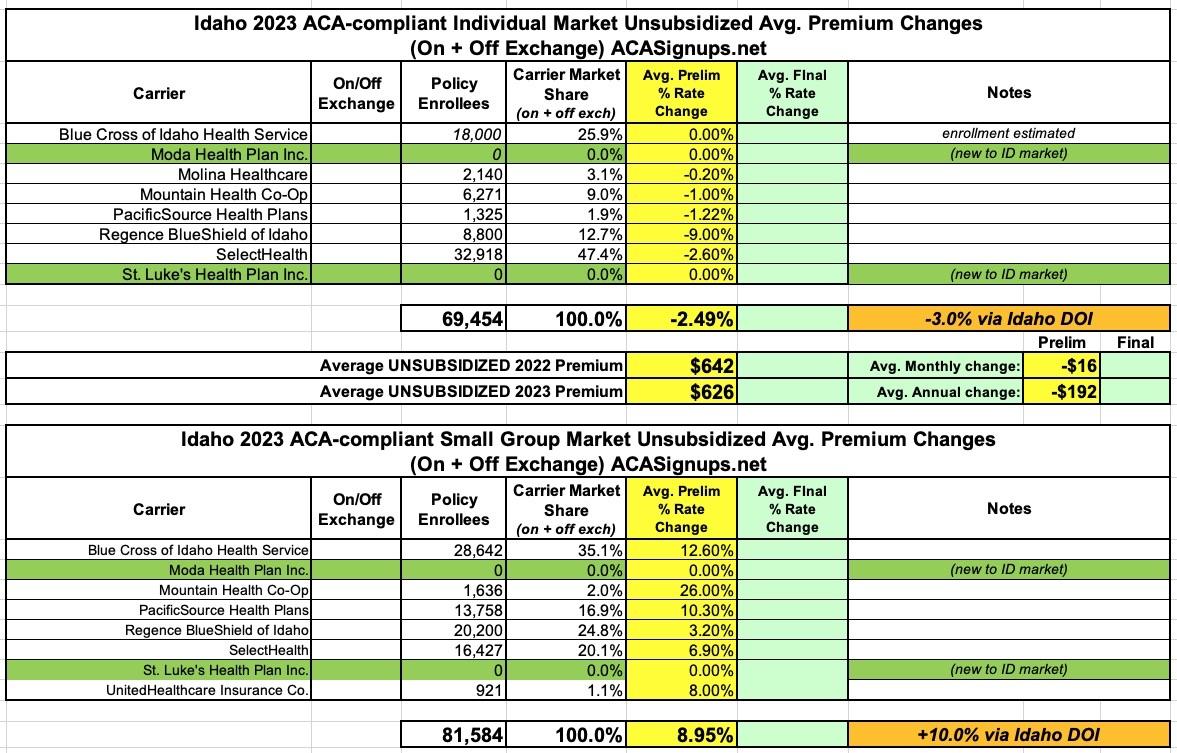Idaho: (Preliminary) avg. unsubsidized 2023 #ACA rate changes: -3.0%
Idaho Rate Review Individual
The Department of Insurance receives preliminary health plan information for the following year from insurance carriers by June 1 and reviews the proposed plan documents and rates for compliance with Idaho and federal regulations.The Department of Insurance does not have the authority to set or establish insurance rates, but it does have the authority to deem rate increases submitted by insurance companies as reasonable or unreasonable. After the review and negotiation process, the carriers submit their final rate increase information.The public is invited to provide comments on the rate changes. Please send any comments to Idaho Department of Insurance.
A key driver of increases is generally the level of health claims paid compared to the premium collected. The table below shows the level of claims paid and premium collected by each insurance company for ACA-compliant health benefit plans during 2021. In addition to claims paid, the premium needs to cover the company’s administrative costs, insurance fees, and taxes. Those costs generally consume around 20 percent of the premium. Larger rate increases may be needed when the prior year’s premium is not sufficient to pay for health claims and administrative costs and fees.With its rate increase submission, each insurance company submits a consumer-oriented explanation of the increase, which is available by clicking on the name of the insurance company in the table below.
Each health benefit plan has an associated “metal level” of Bronze, Silver, Gold, or Catastrophic and offers, at a minimum, Idaho's Essential Health Benefits package.The metal level is assigned based on the policyholder's "cost-sharing," which includes any deductibles, coinsurances, copays, and out-of-pocket maximums. A Silver plan usually will have lower cost-sharing than a Bronze plan, and a Gold plan will usually have lower cost -sharing than a Silver plan.However a Gold plan usually has a higher monthly premium than a Silver plan, and a Silver plan usually has a higher monthly premium than a Bronze plan. Policyholders are able to choose which metal level and which plan within that metal level best works for them.
It's important to note that the rate changes on the actual tables posted on the Insurance Dept. site are rounded off to the nearest percentage. It's also important to note that when I click through to the actual rate filings and plug in the more exact averages along with the number of members to calculate the weighted average, I got slightly different numbers:
- Individual market: I get -2.5% vs. the state's official -3.0%
- Small Group market: I get +9.0% vs. the state's official +10.0%
However, the state's official average is what I have to go with, so there it is:
Also note that for Blue Cross of Idaho, I had to make an educated guess as to the actual total enrollment since it isn't listed in the rate filing itself.
It's also worth noting that of the 21 states (including DC) that I have preliminary 2023 rate filings for, Idaho is the first one looking at average premium reductions on the individual market...in fact, every one of the 6 current carriers is dropping their average rates. There's also two new carriers joining both the individual & small group markets (Moda and St. Luke's).
The small group market, meanwhile, is seeing an unusually high increase. The divergence from the indy market is interesting.




